Peugeot 208 2015 Owner's Manual - RHD (UK, Australia)
Manufacturer: PEUGEOT, Model Year: 2015, Model line: 208, Model: Peugeot 208 2015Pages: 341, PDF Size: 38.75 MB
Page 211 of 341
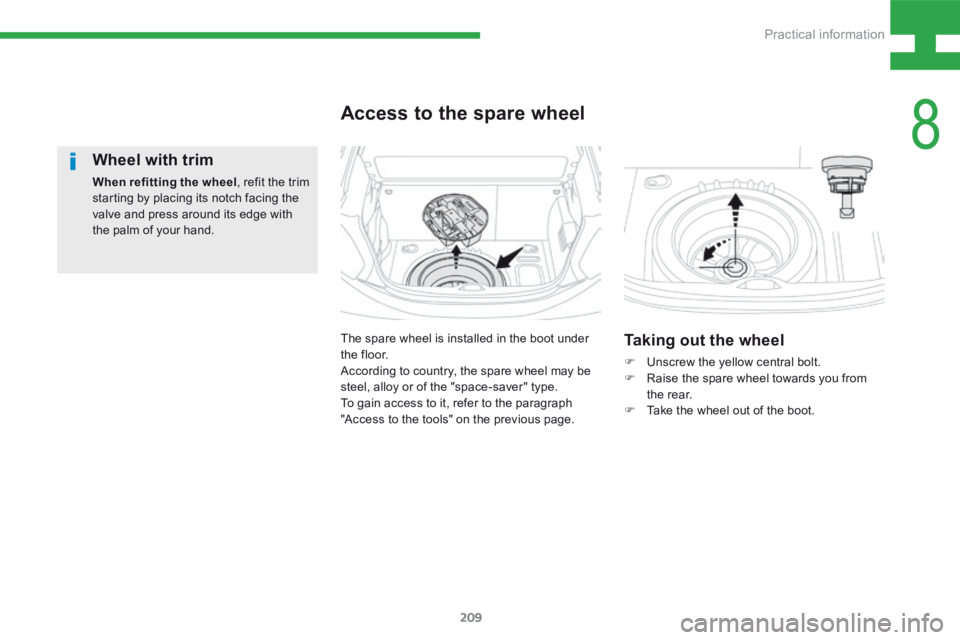
209
208_en_Chap08_Informations-pratiques_ed01-2015
Wheel with trim
When refitting the wheel, refit the trim
starting by placing its notch facing the
valve and press around its edge with
the palm of your hand.
The spare wheel is installed in the boot under
t h e f l o o r.
According to country, the spare wheel may be
steel, alloy or of the "space-saver" type.
To gain access to it, refer to the paragraph
"Access to the tools" on the previous page.
Access to the spare wheel
Taking out the wheel
F Unscrew the yellow central bolt.
F Raise the spare wheel towards you from
the rear.
F Take the wheel out of the boot.
8
Practical information
Page 212 of 341
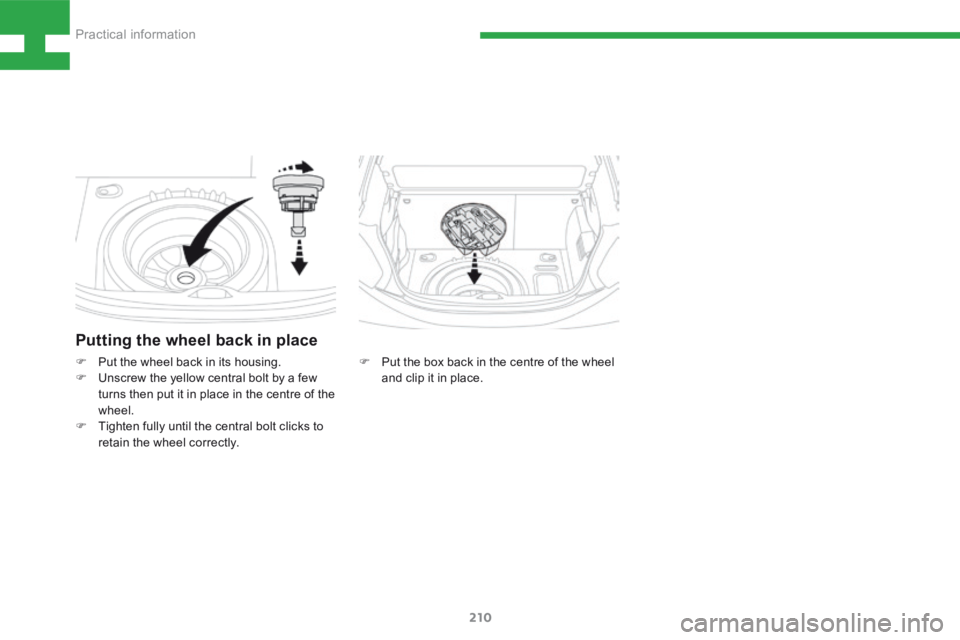
210
208_en_Chap08_Informations-pratiques_ed01-2015
Putting the wheel back in place
F Put the box back in the centre of the wheel
and clip it in place.
F
Put the wheel back in its housing.
F Unscrew the yellow central bolt by a few
turns then put it in place in the centre of the
wheel.
F Tighten fully until the central bolt clicks to
retain the wheel correctly.
Practical information
Page 213 of 341
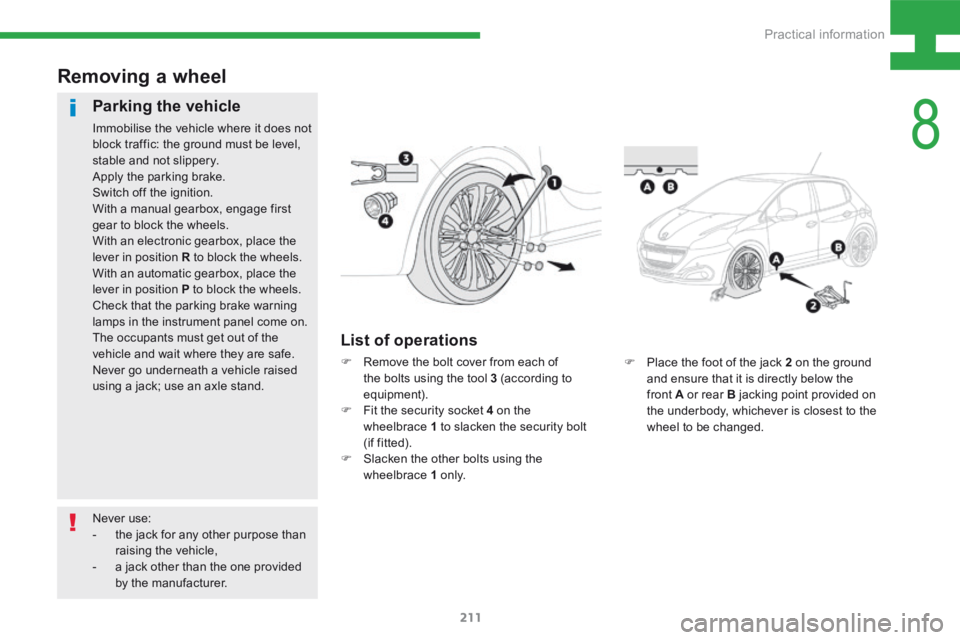
211
208_en_Chap08_Informations-pratiques_ed01-2015
F Place the foot of the jack 2 on the ground
and ensure that it is directly below the
front A or rear B jacking point provided on
the underbody, whichever is closest to the
wheel to be changed.
Removing a wheel
Parking the vehicle
Immobilise the vehicle where it does not
block traffic: the ground must be level,
stable and not slippery.
Apply the parking brake.
Switch off the ignition.
With a manual gearbox, engage first
gear to block the wheels.
With an electronic gearbox, place the
lever in position R to block the wheels.
With an automatic gearbox, place the
lever in position P to block the wheels.
Check that the parking brake warning
lamps in the instrument panel come on.
The occupants must get out of the
vehicle and wait where they are safe.
Never go underneath a vehicle raised
using a jack; use an axle stand.
List of operations
F Remove the bolt cover from each of
the bolts using the tool 3 (according to
equipment).
F Fit the security socket 4 on the
wheelbrace 1 to slacken the security bolt
(if fitted).
F Slacken the other bolts using the
wheelbrace 1 o n l y.
Never use:
- the jack for any other purpose than
raising the vehicle,
- a jack other than the one provided
by the manufacturer.
8
Practical information
Page 214 of 341
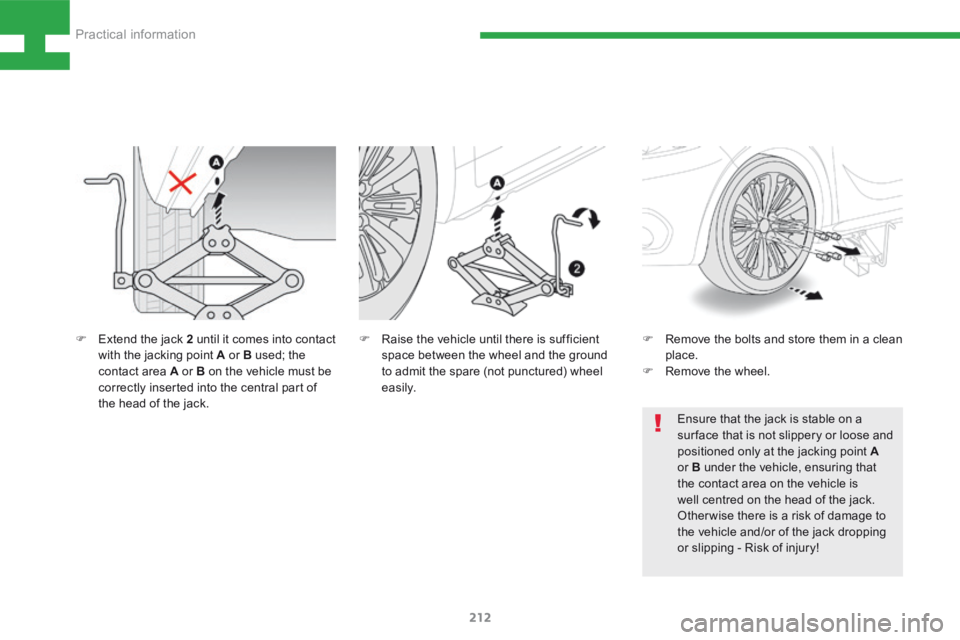
212
208_en_Chap08_Informations-pratiques_ed01-2015
F Remove the bolts and store them in a clean
place.
F Remove the wheel.
F
Extend the jack 2 until it comes into contact
with the jacking point A or B used; the
contact area A or B on the vehicle must be
correctly inserted into the central part of
the head of the jack.
Ensure that the jack is stable on a
sur face that is not slippery or loose and
positioned only at the jacking point A
or B under the vehicle, ensuring that
the contact area on the vehicle is
well centred on the head of the jack.
Otherwise there is a risk of damage to
the vehicle and/or of the jack dropping
or slipping - Risk of injury!
F
Raise the vehicle until there is sufficient
space between the wheel and the ground
to admit the spare (not punctured) wheel
easily.
Practical information
Page 215 of 341
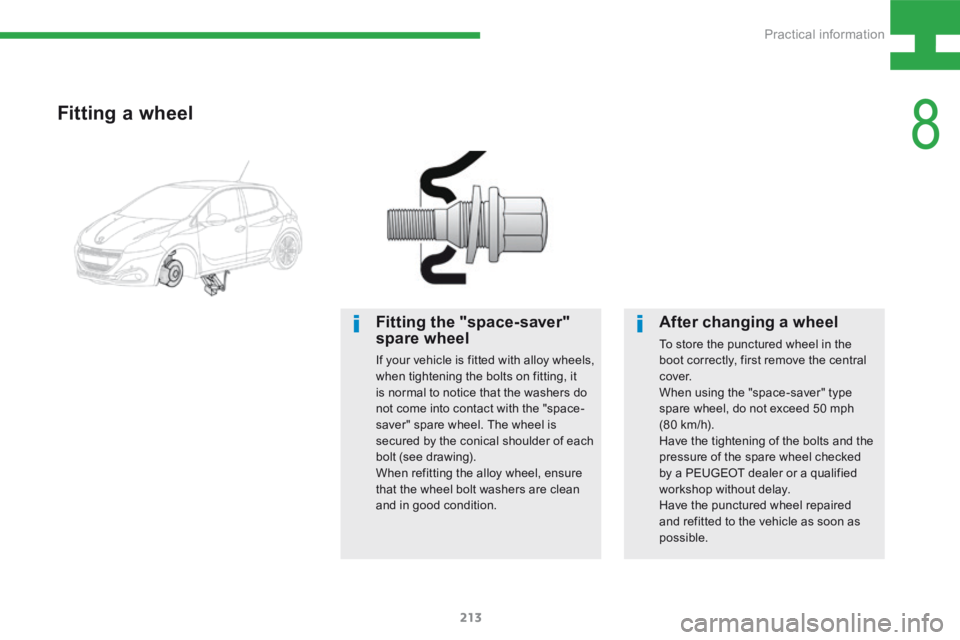
213
208_en_Chap08_Informations-pratiques_ed01-2015
Fitting a wheel
Fitting the "space-saver"
spare wheel
If your vehicle is fitted with alloy wheels,
when tightening the bolts on fitting, it
is normal to notice that the washers do
not come into contact with the "space-
saver" spare wheel. The wheel is
secured by the conical shoulder of each
bolt (see drawing).
When refitting the alloy wheel, ensure
that the wheel bolt washers are clean
and in good condition.
After changing a wheel
To store the punctured wheel in the
boot correctly, first remove the central
c ove r.
When using the "space-saver" type
spare wheel, do not exceed 50 mph
(80 km/h).
Have the tightening of the bolts and the
pressure of the spare wheel checked
by a PEUGEOT dealer or a qualified
workshop without delay.
Have the punctured wheel repaired
and refitted to the vehicle as soon as
possible.
8
Practical information
Page 216 of 341
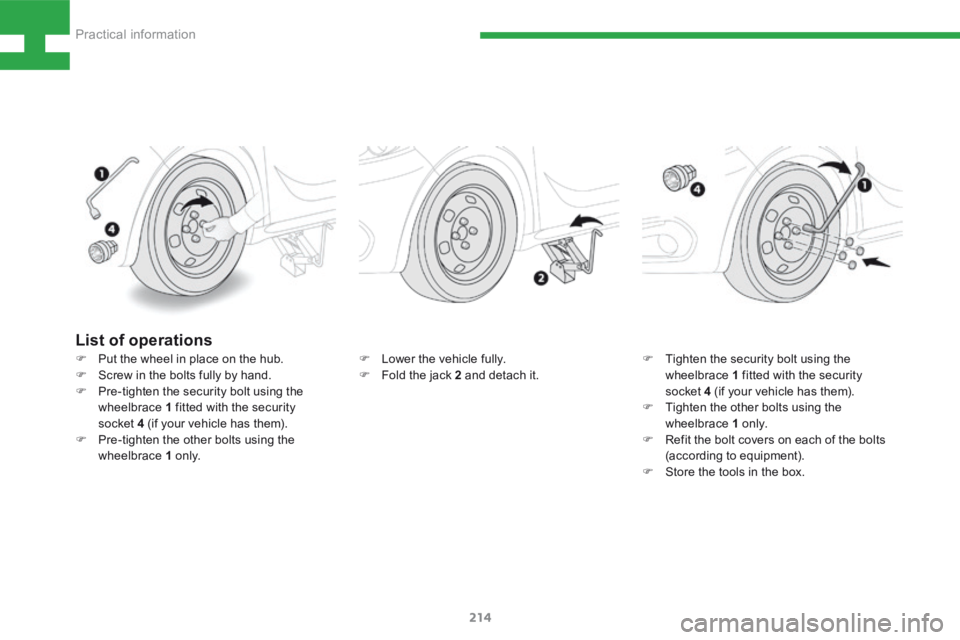
214
208_en_Chap08_Informations-pratiques_ed01-2015
F Lower the vehicle fully.
F Fold the jack 2 and detach it. F
Tighten the security bolt using the
wheelbrace 1 fitted with the security
socket 4 (if your vehicle has them).
F Tighten the other bolts using the
wheelbrace 1 o n l y.
F Refit the bolt covers on each of the bolts
(according to equipment).
F Store the tools in the box.
List of operations
F Put the wheel in place on the hub.
F Screw in the bolts fully by hand.
F Pre-tighten the security bolt using the
wheelbrace 1 fitted with the security
socket 4 (if your vehicle has them).
F Pre-tighten the other bolts using the
wheelbrace 1 o n l y.
Practical information
Page 217 of 341
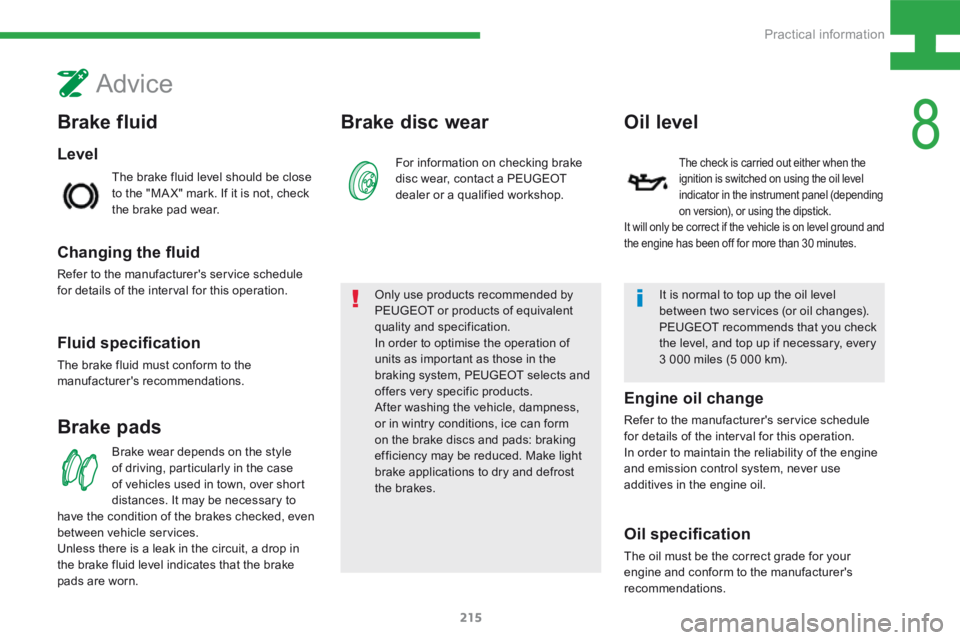
215
208_en_Chap08_Informations-pratiques_ed01-2015
Level
Brake fluid
The brake fluid level should be close
to the "MA X" mark. If it is not, check
the brake pad wear.
Advice
Changing the fluid
Refer to the manufacturer's service schedule
for details of the interval for this operation.
Brake padsBrake disc wear
For information on checking brake
disc wear, contact a PEUGEOT
dealer or a qualified workshop.
Brake wear depends on the style
of driving, particularly in the case
of vehicles used in town, over short
distances. It may be necessary to
have the condition of the brakes checked, even
between vehicle services.
Unless there is a leak in the circuit, a drop in
the brake fluid level indicates that the brake
pads are worn. Only use products recommended by
PEUGEOT or products of equivalent
quality and specification.
In order to optimise the operation of
units as important as those in the
braking system, PEUGEOT selects and
offers very specific products.
After washing the vehicle, dampness,
or in wintry conditions, ice can form
on the brake discs and pads: braking
efficiency may be reduced. Make light
brake applications to dry and defrost
the brakes.
Fluid specification
The brake fluid must conform to the
manufacturer's recommendations.
It is normal to top up the oil level
between two services (or oil changes).
PEUGEOT recommends that you check
the level, and top up if necessary, every
3 000 miles (5 000 km).
Oil level
The check is carried out either when the
ignition is switched on using the oil level
indicator in the instrument panel (depending
on version), or using the dipstick.
It will only be correct if the vehicle is on level ground and
the engine has been off for more than 30 minutes.
Engine oil change
Refer to the manufacturer's service schedule
for details of the interval for this operation.
In order to maintain the reliability of the engine
and emission control system, never use
additives in the engine oil.
Oil specification
The oil must be the correct grade for your
engine and conform to the manufacturer's
recommendations.
8
Practical information
Page 218 of 341
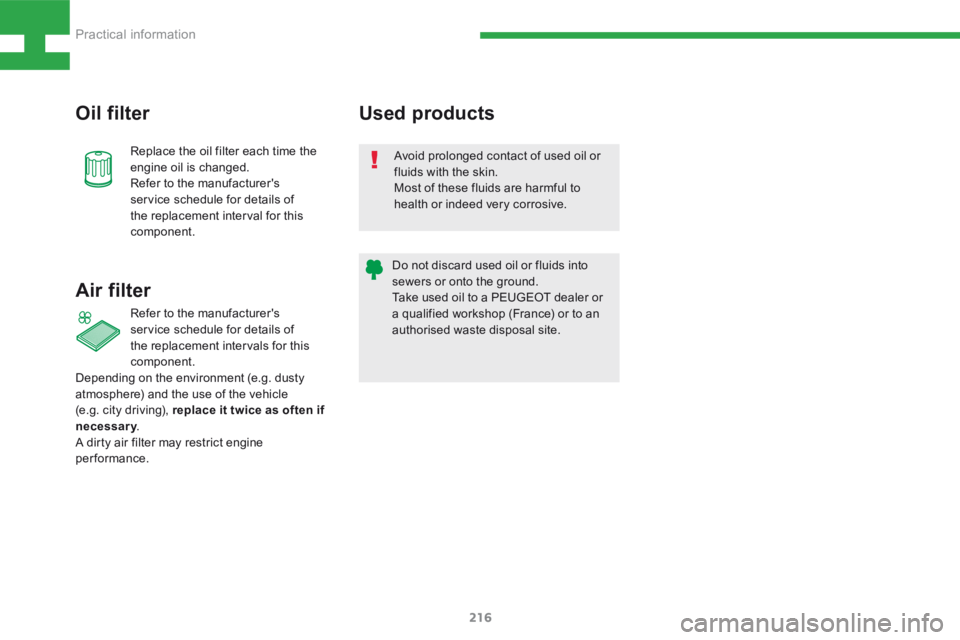
216
208_en_Chap08_Informations-pratiques_ed01-2015
Avoid prolonged contact of used oil or
fluids with the skin.
Most of these fluids are harmful to
health or indeed very corrosive.
Do not discard used oil or fluids into
sewers or onto the ground.
Take used oil to a PEUGEOT dealer or
a qualified workshop (France) or to an
authorised waste disposal site.
Used products
Oil filter
Replace the oil filter each time the
engine oil is changed.
Refer to the manufacturer's
service schedule for details of
the replacement interval for this
component.
Air filter
Refer to the manufacturer's
service schedule for details of
the replacement intervals for this
component.
Depending on the environment (e.g. dusty
atmosphere) and the use of the vehicle
(e.g. city driving), replace it twice as often if
necessary .
A dirty air filter may restrict engine
performance.
Practical information
Page 219 of 341
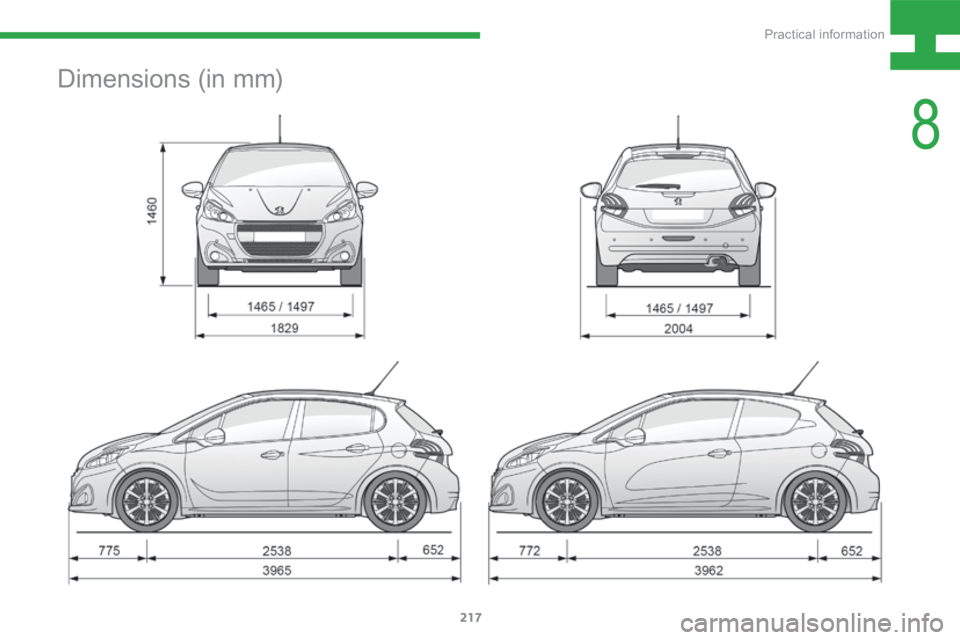
217
208_en_Chap08_Informations-pratiques_ed01-2015
Dimensions (in mm)
8
Practical information
Page 220 of 341
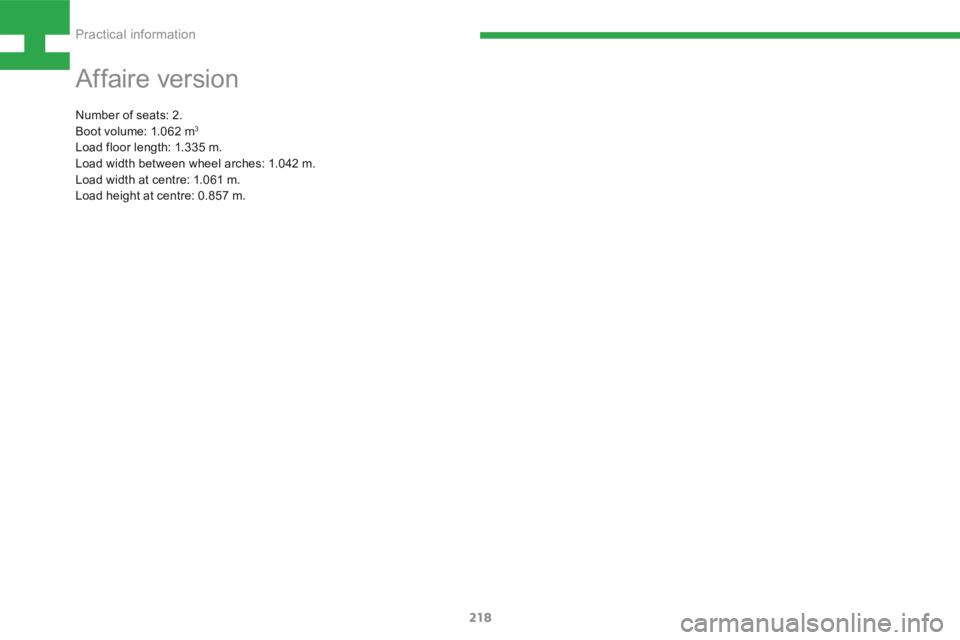
218
208_en_Chap08_Informations-pratiques_ed01-2015
Affaire version
Number of seats: 2.
Boot volume: 1.062 m3
Load floor length: 1.335 m.
Load width between wheel arches: 1.042 m.
Load width at centre: 1.061 m.
Load height at centre: 0.857 m.
Practical information